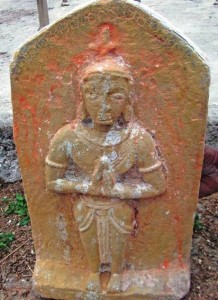
A slab depicts a person with Shivalinga and pitha on his head
Proof of existence of a sect of Shaivism during the Kakatiya rule came to light during a survey and exploratory work conducted by the Archaeological Survey of India in a temple in Mahabubabad district of Telangana recently.
A sculptural slab carved on granite stone illustrating a life-size portrait of a dedicated worshipper of Lord Shiva was discovered in a corner of Sri Agastisvaraswamy temple complex at Abbayapalem village in Maripeda Mandal of the district.
Superintending Archaeologist in Temple Survey Project (Southern Region, ASI) D. Kanna Babu, who is on a mission to explore, ascertain the antiquity and architectural pre-eminence of ancient shrines in Andhra Pradesh and Telangana chanced upon this proof of Lamudigalam — a school of Shaivism prevalent from the 11th C AD to 13th C AD.
The man on the granite slab is seen in vertical position with dignified features and folded hands in worship. The facial features are oval distinguished by wide open eyes and an elongated nose. He wears a dhoti fastened with a broad waist band having a central medallion.
Mr. Kanna Babu says the worshipper sports a beaded necklace, sacred thread, prominent ear rings, arm bands, bracelets and his hair is tied in a circular bun. A small Shivalinga with pitha is adorned by him on his head.
Mr. Kanna Babu told The Hindu, “The discovery of this spectacular portrait sculpture is the first of its kind in the two Telugu States. Unfortunately, a thick coat of colour painted by locals on it during the recent temple festivals had turned it unrecognisable.”
A new school
The uniqueness of the image is that a label inscription in Telugu (from 12th Century AD) is engraved on the top of the sculptural frame and ends at the bottom. The script is self-explanatory: ‘I affectionately adore the linga and placed on my head by tying with my hair.’
The spiritual significance of wearing a Shivalinga on head was considered the most pious act of an ardent devotee of Lord Shiva in the contemporary society of the Kakatiya regime. “The religious connotation of this thematic sculpture is for magnifying the beliefs of the Lamudigalam sect,” the ASI official says.
The prime principle was that one should achieve the state of advaita (non-separation) i.e. there is no difference between Paramatma (Supreme Being) and Jivatma (human being) by practising divine doctrines like Lingadharanam — bearing Shivalinga on his head.
The Agastisvaraswamy temple on the hillock served in those days as the place of worship and the principal seat of this sect finally emerged into Virashaiva aphorism,’ says Kanna Babu who deciphered the inscription.
source: http://www.thehindu.com / The Hindu / Home> News> States> Andhra Pradesh / by Ramesh Susarla Anantapur / November 17th, 2018
ಇನ್ನಷ್ಟು ಮಾಹಿತಿ ಆಂಧ್ರ ಶೈವ ರ ಬಗ್ಗೆ ಬೇಕು